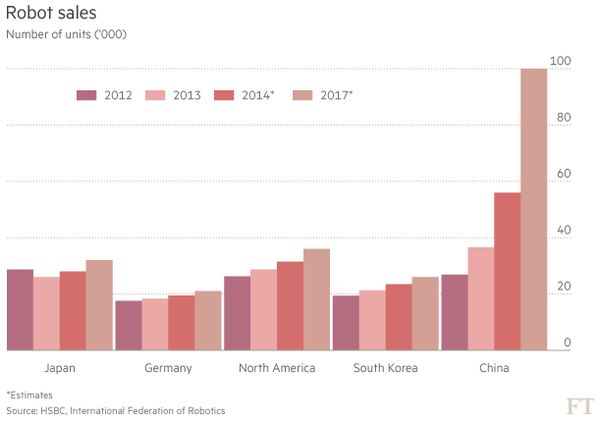
Robohub.org
What’s propelling China’s industrial robot revolution

Xi Jinping, China’s President, last year called for an “industrial robot revolution.” Since then China has created policies giving value added tax refunds and subsidies to companies making robots, and robot user companies can qualify for tax breaks.
The Financial Times reported that analysts are forecasting the payback period for industrial robots with a 10 yr life cycle is 1.7 yrs in 2015, down from 11.8 yrs in 2008 and will likely shorten again to 1.3 years in 2016.
The prospect of being able to pay off the cost of a robot in slightly more than a year, Goldman Sachs says, has brought industrial automation to within the reach of China’s millions of small and medium-sized manufacturers, creating the conditions for a productivity surge.
These two factors (the mandate to use robots and the lower payback metrics) combined with “shrinkage in China’s working age population and the numbers of workers available for production line work” are likely to propel the continued deployment of robots in China and contribute to the huge surge in robot sales in China (as can be seen in the FT chart) and International Federation of Robotics (IFR) statistical data. Further contributing to China’s labor shortage is an elevation in levels of education attainment in young working age adults, causing them to seek non-factory work.
Two recent research reports by ResearchinChina and Huidian Research attest to China’s growing need for robotics across the manufacturing spectrum, from the auto industry to craft breweries. These reports, and others, forecast that by 2017, more industrial robots will be operating in China’s production plants than in the EU or North America. It is expected that global industrial robot sales will grow from 200,000 in 2014 to 400,000 by 2017!
At next week’s big CIROS Show in Shanghai, on July 7th, a joint IFR-CRIA (Chinese Robotics Industry Alliance) roundtable discussion on Innovation on Robot Applications, will also provide a forum where the IFR will present their preliminary industrial robotics recap for the year 2014, which will confirm the radical growth in China’s robot population. The IFR’s annual World Robotics Industrial Robots report for 2015 covering 2014 results will be released this fall and is a worthwhile purchase.
In other news, a recent message to shareholders, Foxconn’s chairman said that he plans to reduce Foxconn’s pressing need to recruit, hire and train up to 30% of their 1.3 million workforce by replacing dull, dirty, ergonomically stressful, and dangerous tasks with robots within the next few years. Displaced workers will be retrained for higher-level jobs.
tags: c-Business-Finance, China, cx-Industrial-Automation


